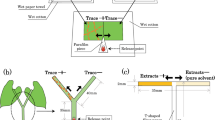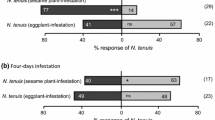Abstract
In this study we investigated the ability of females of the spider wasp, Pepsis thisbe, to detect and respond to chemosensory cues associated with two species of theraphosid hosts (Aphonopelma moderatum and A. texense), as well as a novel chemical cue associated with a stored grain beetle (Tribolium confusum), a species not likely to be encountered by these wasps. Field-collected adult wasps were subjected to choice experiments where they were exposed to a piece of filter paper conditioned with one of these treatment cues versus one sprayed with water (control). One half of the floor of a test chamber contained the treatment cue, while the other contained the control paper. For each trial, the amount of time spent on each paper was recorded. Wasps spent significantly more time on paper conditioned with chemical cues associated with A. moderatum than they did on paper conditioned with cues from A. texense or T. confusum. In addition, field data collected at the study site in southern Texas (Zapata County), showed that over 91.2% of all P. thisbe larvae were found attached to A. moderatum as compared to only 8% for A. texense, despite the fact that the abundance and size of these two theraphosids were similar. Eighty-one percent of all paralyzed A. moderatum found with wasp larvae attached to their bodies were females.
Similar content being viewed by others
References
Bernays, E. A. (1993). Aversion learning and feeding. In Papaj, D. R., and A. C. Lewis (eds.), Insect Learning: Ecological and Evolutionary Perspectives, Chapman and Hall, London, pp. 1–18.
Carriker, M. R., and van Zandt, D. (1972). Predatory behavior of a shell-boring muricid gastropod. Behav. Marine Anim. 1: 157–244.
Cazier, M. A., and Mortenson, M. (1964). Bionomical observations on tarantula hawks and their prey (Hymenopteras: Pompilidae). Ann. Entomol. Soc. Amer. 57: 533–541.
Chapman, R. F., Bernays, E., and Stoffaland, A. (1987). Perspectives in Chemoreception and Behavior, Springer, New York.
Chivers, D. P., and Smith, R. J. F. (1998). Chemical alarm signalling in aquatic predator-prey systems: A review and prospectus. Ecoscience 5: 339–352.
Dicke, G., Halloway, M. T., and Harris, E. D. (1992). Use of various cues in the detection of prey in spider mites. J. Chem. Ecol. 3: 407–412.
Doutt, R. L. (1959). The biology of parasitic Hymenoptera. Annu. Rev. Entomol. 4: 161–182.
Evans, H. E., and Eberhard, M. (1970). The Wasps, University of Michigan Press, Ann Arbor, Michigan.
Field, J. (1992). Guild structure in solitary hunting wasps (Hymenoptera: Pompilidae) compared with null predictions. Ecol. Entomol. 17: 198–208.
Foelix, R. (1996). The Biology of Spiders, Oxford Univ. Press, Oxford.
Hölldobler, B., and Wilson, E. O. (1994). Journey to the Ants, Harvard Univ. Press, Cambridge, Massachusetts.
Hurd, P. D. (1952). Revision of Nearctic species of the genus Pepsis (Hymenoptera: Pompilidae). Bull. Am. Mus. Nat. Hist. 98: 261–334.
Kats, L. B., and Dill, L. M. (1998). The scent of death: Chemosensory assessment of predation risk by prey animals. Ecoscience 5: 361–394.
Lima, S. L., and Dill, L. M. (1990). Behavioral decisions made under risk of predation: A review and prospectus. Can. J. Zool. 68: 619–640.
Lucas, R. (1919). Pompiliden-Studien. Arch. Naturgesch. 83A: 1–180.
Passmore, L. (1936). Tarantula and tarantula hawk. Nat. Mag. 27: 31–40.
Persons, M. R., Walker, S. E., Rypstra, A. L., and Marshall, S. D. (2001). Wolf spider predator avoidance tactics and survival in the presence of diet-associated predator cues (Araneae: Lycosidae). Anim. Behav. 61: 43–51.
Petrunkevitch, A. (1926). Tarantula versus tarantula hawk wasp: A study in instinct. J. Exp. Biol. 45: 367–394.
Petrunkevitch, A. (1952).The spider and the wasp. Sci. Am. 187: 20–24.
Punzo, F. (1994a). The biology of the spider wasp Pepsis thisbe (Hymenoptera: Pompilidae) from Trans Pecos Texas. I. Adult morphometrics, larval development, and the ontogeny of larval feeding. Psyche 101: 229–241.
Punzo, F. (1994b). The biology of the spider wasp Pepsis thisbe (Hymenoptera: Pompilidae) from Trans Pecos Texas. II. Temporal patterns of activity and hunting behavior, with special reference to the efffects of experience. Psyche 101: 243–256.
Punzo, F. (1996). Localization of brain function and neurochemical events associated with learning in insects. Rec. Trends Comp. Biochem. Physiol. 2: 9–16.
Punzo, F. (1998). The Biology of Camel-Spiders (Arachnida, Solifugae), Kluwer, Norwell, MA.
Punzo, F. (2000). Desert Arthropods: Life History Variations, Springer, Heidelberg, Germany.
Punzo, F. (2002). Food imprinting and subsequent prey preference in the lynx spider, Oxyopes salticus (Araneae: Oxyopidae). Behav. Process. 58: 177–182.
Punzo, F. (2005). Studies on the natural history, ecology and behavior of Pepsis cerberus and Pepsis mexicana (Hymenoptera: Pompilidae) from Big Bend National Park, Texas. J. NY Entomol. Soc. 113: 84–95.
Punzo, F., and Garman, B. (1989). Effects of encounter experience on hunting behavior of the spider wasp, Pepsis formosa (Say) (Hymenoptera: Pompilidae). Southwest. Nat. 34: 513–518.
Punzo, F., and Kukoyi, O. (1997). The effects of prey chemical cues on patch residence time in the wolf spider Trochosa parthenus (Chamberlin) (Lycosidae) and the lynx spider Oxyopes salticus Hentz (Oxyopidae). Bull. Br. Arachnol. Soc. 10: 323–326.
Schmidt, J. O. (2004). Venom and the good life in tarantula hawks (Hymenoptera: Pompilidae): How to eat, not be eaten, and live long. J. Kansas Entomol. Soc. 77: 402–413.
Sokal, B. F., and Rohlf, F. J. (1995). Biometry, 3rd edn., W. H. Freeman, New York.
Turlings, T. C. J., Wackers, F. L., Vet, L. E. M., Lewis, W. J., and Tumlinson, J. H. (1993). Learning of host-finding cues by Hymenopterous parasitoids. In Papaj, D. R., and A. C. Lewis (eds.), Insect Learning: Ecological and Evolutionary Perspectives, Chapman and Hall, London, pp. 51–78.
Vet, L. E. M., Lewis, W. J., and Card, R. T. (1995). Parasitoid foraging and learning. In Bell, W., and W. J. Card (eds.), Chemical Ecology of Insects, Chapman and Hall, London, pp. 346–378.
Williams, F. X. (1956). Life history studies of Pepsis and Hemipepsis wasps in California (Hymenoptera: Pompilidae). Ann. Entomol. Soc. Am. 49: 447–466.
Wilson, D. S. (1978). Prudent predation: A field study involving three species of tiger beetles. Oikos 31: 128–136.
Author information
Authors and Affiliations
Corresponding author
Rights and permissions
About this article
Cite this article
Punzo, F., Ludwig, L. Behavioral Responses of Pepsis thisbe (Hymenoptera: Pompilidae) to Chemosensory Cues Associated with Host Spiders. J Insect Behav 18, 757–766 (2005). https://doi.org/10.1007/s10905-005-8738-0
Revised:
Accepted:
Issue Date:
DOI: https://doi.org/10.1007/s10905-005-8738-0





